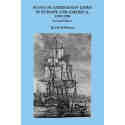During the 16th and 17th centuries, there was significant emigration, both permanent and temporary, from Scotland to the Scandinavian lands of Norway, Sweden, and Denmark. Some of this was by economic migrants, especially merchants and craftsmen, in search of career opportunities, but most Scots went as soldiers of fortune seeking employment in the armies of Sweden and Norway-Denmark, especially under the monarchy of Gustavus Adolphus. Recent research indicates that between 1627 and 1629 around 13,700 Scots entered Danish service, and that in 1631 there were 20,000 Scots in Swedish service. Many of those soldiers who survived campaigns, especially the Thirty Years War, were granted land and encouraged to settle. The merchants and craftsmen who immigrated to Scandinavia generally originated from burghs along the east coast of Scotland and as far north as the Orkney and Shetland Islands. There were also significant trading links between Scottish ports such as Leith, Anstruther, Perth, Dundee, Montrose, and Aberdeen to Norwegian ports such as Bergen, Trondheim, Stavanger, and Christiansand; to Swedish ports such as Gothenburg and Stockholm; and, to a lesser extent, to Copenhagen in Denmark, which led to merchants settling there. In Stockholm there were several Scottish goldsmiths and silversmiths; one Blasius Dundee acted as banker to the Swedish king in the 16th century. Soldiers were recruited from all parts of Scotland, though some regiments, such as that of Colonel Robert Munro, alias Lord Reay, were mainly recruited in the northern Highlands. On the outbreak of the Bishop’s War in 1638 (the start of the Wars of the Three Kingdoms), many of the Scottish soldiers returned home from Scandinavia to form the backbone of the Covenanter Army that successfully opposed the forces of King Charles I.
The Swedish and Danish kings recruited not only soldiers from Scotland but also seafarers. Experienced Scottish seafarers were employed in various capacities; for example, John Cunningham led a naval expedition to Greenland and Labrador in 1605. Later he became governor of Vardohu and Finmark in northern Norway. Several of the admirals of the Swedish Navy belonged to the Scottish Clerck family. Sanders Clerck took part in the Swedish expedition to the Delaware in 1639, while Richard Clerck acted as commissary of the Swedish West India Company around 1646.
Following the losing campaigns in 1715 and 1746, a number of Scottish Jacobites sought refuge in Sweden: some, such as the Carnegies, became burghers of Gothenburg. That city was also home to the Swedish East India Company, which was created around 1730 to rival the English and the Dutch East India companies. One of its more prominent employees was Colin Campbell, who was sent to China in 1731 to establish trading links. The industrialization of Gothenburg in the 19th century was facilitated by Scottish entrepreneurs such as James Dickson, William Gibson, and Alexander Keiller.
In the early modern period, tens of thousands of Scots settled in Scandinavia, some permanently and others temporarily. Some of them, or their descendants, were involved in trade and settlement in the Americas. A handful of Scots were engaged in the Swedish settlements on the Delaware as colonists, seafarers, or merchants based in Sweden and trading in colonial produce. Far more Scots were recorded as planters and merchants in the Danish West Indian Colony of the Virgin Islands—St. Jan, St. Thomas, and St. Croix–during the 18th and 19th centuries.
This Second Edition expands on and vastly supersedes the original. It is based on numerous primary and secondary sources located in Scotland and Scandinavia, including the Prerogative Court of Canterbury; Public Record Office, Northern Ireland; Rigs Arkivet, Kobenhavn; Stads Arkivet, Bergen; and the Swedish Military Archives.
For each Scots-Scandinavian named in the volume, Dr. Dobson provides a name, specific place, a date, and the source. In many instances we also learn about the individual’s occupation, relations, vessel traveled upon, battles fought in, and more.




